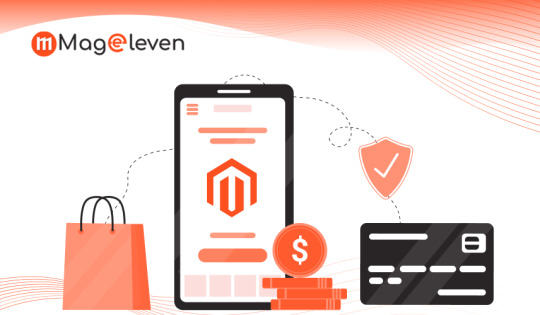I’m Ava Johnson, a Magento Developer at Mageleven. I love creating eCommerce solutions that are simple and sophisticated. Using my strong knowledge of Magento, I specialize in tailoring solutions that perfectly fit our customers’ needs. Whether I am customizing the themes or adding complex features, I am passionate about bringing ideas to life and delivering high-quality results. At Mageleven, I am part of a vibrant team that works together to bring innovative solutions to life and drive success in the ever-changing world of eCommerce.
Don't wanna be here? Send us removal request.
Text
0 notes
Text
1 note
·
View note
Text
0 notes
Text
1 note
·
View note
Text
1 note
·
View note
Text
How to Optimize Conversion Rates for Your Magento Store
Improving the conversion rate of your Magento store is essential for increasing sales and maximizing the return on your marketing efforts. Here are some effective strategies to boost conversions and create a seamless shopping experience for your customers.
Find the Effective Strategies to Boost Conversions
1. Improve Website Speed & Performance
A slow-loading website can drive potential customers away, increasing your bounce rate and reducing conversions. To improve speed:
Enable full-page caching in Magento.
Optimize images using tools like TinyPNG.
Use a Content Delivery Network (CDN) to distribute content faster.
Choose a fast Magento hosting provider.
2. Ensure Mobile-Friendly Design
Since a large portion of online shoppers use mobile devices, your Magento store must be mobile-responsive. A responsive design ensures a smooth experience across all screen sizes, reducing frustration and increasing engagement.
3. Simplify the Checkout Process
A long and complicated checkout process leads to cart abandonment. Streamline the process by:
Offering guest checkout (no forced account creation).
Reducing unnecessary form fields.
Providing multiple payment options like PayPal, credit cards, and Buy Now Pay Later services.
Displaying progress indicators so users know how many steps are left.
4. Optimize Product Pages for Higher Conversions
Your product pages should provide all necessary information to convince customers to buy. Improve them by:
Using high-quality product images and videos.
Writing detailed product descriptions with key features and benefits.
Highlighting customer reviews and ratings to build trust.
Adding clear call-to-action (CTA) buttons like “Add to Cart” or “Buy Now.”
5. Use AI-Powered Personalization & Product Recommendations
Leverage Magento’s AI capabilities to personalize shopping experiences. Display recommended products based on user behavior, past purchases, or browsing history. Personalization makes shopping more engaging and encourages impulse purchases.
6. Create Urgency with Limited-Time Offers & Discounts
Encourage quick buying decisions by offering:
Flash sales and time-limited discounts.
Free shipping for a limited time.
Low stock alerts (e.g., “Only 3 left in stock!”).
Exit-intent popups with discount codes to prevent users from leaving.
7. Implement SEO Best Practices
A well-optimized store attracts more organic traffic, leading to more conversions. Follow these Magento SEO strategies:
Use relevant keywords in product titles, descriptions, and meta tags.
Optimize your site’s speed and mobile usability.
Implement structured data for better search engine visibility.
Use Magento SEO extensions to automate improvements.
8. Offer Live Chat & Strong Customer Support
Customers often have questions before making a purchase. By offering live chat or AI-powered chatbots, you can provide real-time assistance, answer concerns, and increase trust. Additionally, ensure:
Fast email and phone support.
A well-structured FAQ section to address common concerns.
Easy returns and refund policies to reduce purchase hesitation.
Conclusion
By implementing these Magento conversion rate optimization strategies, you can create a seamless shopping experience, encourage customers to buy, and increase sales. Keep testing different tactics and use analytics tools to track performance and continuously improve your eCommerce store.
1 note
·
View note
Text
1 note
·
View note
Text
1 note
·
View note
Text
1 note
·
View note
Text
How to Configure Payment Restrictions in Magento 2?
Payment restrictions in Magento 2 enable store owners to restrict buyers' payment options based on specific requirements. This is necessary for companies that want to offer alternative payment options to specific groups of buyers, orders with specific values, or shipping addresses. Here, we will present a simple and effective way to set payment restrictions in Magento 2.
Why Configure Payment Restrictions in Magento 2?
Payment restrictions make your store safer, more efficient, and more convenient for your customers. Let's find out why:
Enhanced Security: Block high-risk payment types for specific locations or orders.
Better Customer Experience: Show relevant payment options about user behavior or cart information.
Compliance with Business Rules: Ensure payment options comply with regional laws and commercial terms.

Step-by-Step Guide to Configuring Payment Restrictions in Magento 2
Follow these easy steps to configure payment restrictions and customize your payment methods for the best results.
Step 1: Log in to the Admin Panel
Start by logging into your Magento 2 Admin Panel. Once inside, navigate to Stores > Configuration > Sales > Payment Methods.
Step 2: Choose the Payment Method
In the Payment Methods section, select the payment method you want to apply restrictions to. Each method has different configuration options, so be sure to choose carefully based on your business needs.
Step 3: Configure General Settings
Here, you’ll find options to enable or disable the payment method, set its title, and define specific rules for its availability. Make sure to:
Enable the payment method.
Set a clear and customer-friendly title.
Add instructions if needed.
Step 4: Use Conditions to Set Restrictions
Magento 2 allows you to apply payment restrictions using various conditions, such as:
Customer Groups: Limit certain payment methods to specific groups like wholesale, B2B, or VIP customers.
Shipping Countries: Restrict payment methods based on the shipping destination.
Order Amount: Enable or disable payment methods depending on the order total.
Product Categories: Apply restrictions for specific product types.
To configure these restrictions, navigate to the Advanced Settings section and select the desired conditions from the drop-down menu.
Step 5: Save the Configuration
After setting the conditions, click Save Config at the top right corner of the page. Your changes will be applied immediately. Test the configuration on the frontend to ensure it works as expected.
Best Practices for Setting Payment Restrictions
To make the best use of Magento 2’s payment restriction feature, follow these best practices:
Analyze Customer Behavior: Study your customer base and offer payment options that align with their preferences.
Test Your Restrictions: Ensure the restrictions work appropriately through testing under several scenarios.
Avoid Over-Restricting: Too many restrictions may lead to cart abandonment. Keep it simple and user-friendly.
Stay Updated: Regularly review your payment restrictions to match new business needs or legal requirements.
Benefits of Using Payment Restrictions
Implementing payment restrictions can yield dividends for your store:
Higher Conversion Rates: Displaying only relevant payment options reduces uncertainty and hastens checkout.
Risk Reduction: Minimize fraudulent transactions by blocking certain payment methods for high-risk regions.
Improved Operations: Streamline your payment processes and simplify them for various segments of your customers to shop with ease.
Conclusion
Configuring payment restrictions in Magento 2 is not just a technical configuration but a smart decision to enhance your store’s performance and your buyers’ happiness. By providing custom payment options, your store becomes a one-stop-shop for your buyers, and your store is protected from any future vulnerabilities. Regardless of your target group, your region, your fraud concerns, or your specific needs, with this feature, all your freedom and control are at your disposal.
Take the time to review your store’s requirements and follow these steps to streamline your payment process. Monitor and update your settings from time to time to adapt to changing customer behavior and grow your business. In the long run, a proper payment strategy will enable you to increase conversions, streamline operations, and build deeper relationships with customers.
For a detailed blog, visit: https://mageleven.com/blog/post/easy-steps-to-configure-payment-restrictions-in-magento-2.html
1 note
·
View note
Text
Steps to Configure Shop by Brand in Magento 2?
Improving your Magento 2 store with the “Shop by Brand” feature can contribute greatly to improving customer experience, increasing brand awareness, and boosting conversions. Shop by Brand helps buyers to easily navigate and shop through their favorite brands. Here's a straightforward guide to setting up Shop by Brand in Magento 2.
1. Install a Reliable Shop by Brand Extension
Start by selecting and deploying a reliable “shop by brand” module compatible with Magento 2. Start with a reliable shop by brand module like Mageleven. Shop by brand modules make configuration easy and have additional capabilities that work in buyers’ favor when searching for brands.
2. Configure General Settings
After installation, configure the extension to align with your store's requirements:
Enable the Extension: from the admin panel of Magento, navigate to Stores > Configuration.
Select Brand Attribute: Choose the attribute that represents brands in your product catalog.
Set URL Key: Define a user-friendly URL key for brand pages, such as "brand" or "shop-by-brand".
Assign CMS Page: Select or create a CMS page to serve as the "All Brands" listing.
3. Create and Assign Brand Attributes
Organize your products by assigning them to their respective brands:
Navigate to Product Attributes: Go to Stores > Attributes > Product.
Create or Edit Brand Attribute: If a brand attribute doesn't exist, create one. Set the input type to "Dropdown" or "Visual Swatch" for better user experience.
Enable in Layered Navigation: This allows customers to filter products by brand on category pages.
Add Brand Details: Input brand names and upload corresponding logos.

4. Design Brand Pages
Create dedicated pages for each brand to showcase their products:
All Brands Page: Develop a comprehensive page listing all available brands, possibly organized alphabetically or by popularity.
Individual Brand Pages: For each brand, create a page featuring its logo, description, and product listings.
5. Enhance Navigation with Brand Filters
Improve product discoverability by adding brand filters:
Layered Navigation: Integrate brand filters into your store's layered navigation, allowing customers to refine product searches by brand.
Menu Links: Add direct links to popular brands in your main menu or sidebar for quick access.
6. Optimize Brand Pages for SEO
Ensure your brand pages are search-engine friendly:
Unique Meta Titles and Descriptions: Craft distinct meta titles and descriptions for each brand page.
SEO-Friendly URLs: Use clean and descriptive URLs for brand pages.
Rich Content: Include detailed brand descriptions, images, and other relevant content to improve search rankings.
7. Regularly Update and Manage Brands
Keep your brand offerings current:
Add New Brands: As you partner with new brands, promptly add them to your store.
Update Brand Information: Regularly review and update brand logos, descriptions, and product associations.
Monitor Performance: Use analytics to track the performance of brand pages and make data-driven improvements.
By implementing these, your "Shop by Brand" can have a perfect one in your Magento 2 store, driving sales and pleasing your customers.
For a detailed blog, visit:
https://mageleven.com/blog/post/how-to-setup-shop-by-brand-in-magento-2.html
1 note
·
View note
Text
Why should you choose Magento for scalable eCommerce growth in 2025?
Any business contributing to the continued growth in the e-commerce sector needs scalability, flexibility, and high performance. Magento 2, strong in features with advanced capabilities, is still a good choice in 2025 for scalable growth in e-commerce.
Unmatched Scalability and Flexibility
Magento is designed to support everything from small businesses to large enterprises. Whether it’s the early stages or a rapid growth phase, Magento 2 will scale up with ease. With multi-store functionality, customizable themes, and advanced APIs, it allows for business growth without any restrictions.
Powerful Performance and Speed
Along with its importance for SEO and user experience, website speed and performance are unrivaled. Advanced caching, database optimization, and cloud hosting mean Magento 2 will see your online store running smoothly during high-traffic periods.
Advanced Customization and Extensions
Magento has thousands of top extensions and integrations that allow you to enhance the store's functions in every aspect. From AI-powered product recommendations to advanced analytics and CRM integrations, among many others, the list is pretty long with Magento.

Mobile-First and SEO-Friendly
With the explosive growth of mobile commerce, Magento 2 has ensured that the store is responsive and fully optimized for mobile. This also includes built-in SEO: customizable URLs, meta tags, and XML sitemaps will help the store appear higher in search results.
Secure and Future-Proof
Security is the most important issue for online business. For customers, it saves information securely through regular updates of Magento 2, PCI compliance, and good data encryption. Thanks to constant development and a huge community, Magento remains a future-proof e-commerce software.
Magento 2 remains the number one choice among companies targeting scalable, high-performance solutions for e-commerce in 2025, with the ability to adapt to fit their business with extreme flexibility, advanced security features, and unprecedented functionality.
For more information on top Magento Custom Development Services, visit: https://mageleven.com/custom-development-services
1 note
·
View note
Text
Magento 2: New Features That Transform Online Stores
Magento 2 has changed the world of e-commerce due to its powerful features and enhancements from its initial version, Magento 1. It assures speed, improved user experience, and enhanced functionality, making it an ideal platform for modern-day businesses.
Following are some of the major features introduced in Magento 2:
1. Enhanced Performance and Scalability
Magento 2 is designed to handle high traffic and large catalogs efficiently. It features full-page caching, which reduces page load times from 5-10 seconds to 1-2 seconds. Moreover, it supports database sharding and optimized indexing, which means even large-scale stores will run seamlessly.
2. Smooth Checkout Process
Magento 2 features a two-step checkout, which is really simple and reduces cart abandonment rates. It is fast and intuitive; customers are able to place orders in fewer steps. Moreover, it has support for guest checkout, thus allowing new customers to make purchases without creating an account.
3. Mobile-Friendly Design
With the growing trend of mobile commerce, Magento 2 offers responsive themes to ensure the best experience with any device. For store owners, the admin panel is optimized for mobile from the backend side.
4. Improved Admin Interface
The new Admin panel is much more user-friendly and intuitive. It allows you to work in a customized dashboard, making the job of the administrator easier by managing orders, customers, products, and reports more efficiently. This saves time and increases productivity even for non-technical users.

5. Advanced Reporting and Analytics
Advanced reporting capabilities in Magento 2 allow for in-depth tracking of sales, orders, and customer data. The integration of Google Analytics and other tracking tools enables the store owner to make decisions based on facts.
6. Built-In Extensions and Improved Customization
Supports a wide array of Magento 2 extensions that enhance the functionality of your store. The modular code structure allows developers to customize and scale the platform with ease.
7. Better Security Features
Magento 2 is secured by: hashed passwords, protection against CSRF, improved session management, and regular updates to keep it secure from all types of vulnerabilities.
8. Multi-Store and Multi-Language Support
Magento 2 supports multiple stores, currencies, and languages, making it a great choice for international businesses.
Conclusion
The new features of Magento 2 allow store owners to provide their customers with a great shopping experience while having less hassle from the backend. The performance boost is exactly what every web store needs, as it improves the page loading speed and seamless browsing experience that customers desire so much and brings better conversions. Scalable and flexible, Magento can suit any size of store – whether it is running a small shop or a multinational company that needs to meet multiple demands.
With this state-of-the-art admin interface, the time and effort for store managers will be reduced in such a way that even non-developers can actually start thinking about store strategy and growth. Meanwhile, with advanced reporting in combination with analytics, actionable insights have provided avenues through which store owners will definitely make informed strategic decisions to achieve the best level of business output.
Overall, with Magento 2, the future is bright, and so is the powerhouse. Whether it is to improve customer experience, boost sales, or manage operations easily- all the tools and features are available to stand strong in the competitive online market. So, to succeed in business in today's era, upgrading to Magento 2 is a necessity rather than an option.
For more information about features, extensions and services visit: https://mageleven.com/
1 note
·
View note